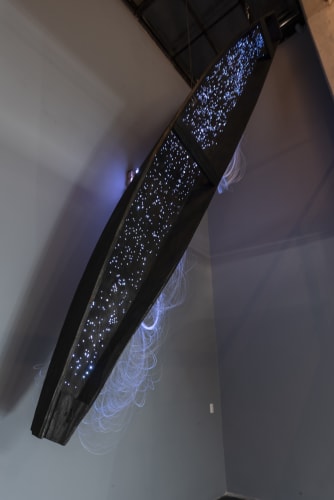TIC TAC: Miler Lagos
This exhibition is an amplified time capsule that we can tour.
Tic Tac
We all know that Tic-Tac is a small, transparent box with an audible seal, like our own personal capsule we can carry in our pockets. This exhibition is an amplified time capsule that we can tour. Michel Serres joins me in saying: yes, this exhibition conceives the room as a container that seeks to acknowledge reality by saving it, like a grieving process that makes sense of residue.
«Tic-Tac is a time capsule that allows me to refer to different occurrences in my contemporaneity that interest me», Says Miler Lagos. So, first of all, we find a capsule in the gallery, as is, with remains of history, such as those that are launched into space. Miler tells us: «I have always been fascinated by the phenomenon of the UFO, and once I heard of a strange ship that looked like a tightly shut white capsule, lacking doors, windows, or propellers, and that reached unbelievable speeds, I thought: any hall, ship, or plane, is already an archive in time; the result of the information we have gathered».
And with all the freedom of thought that is characteristic of art, and trusting the relentless experimental craftsmanship, Miler Lagos builds a capsule covered in newspaper cutouts; cutouts from El Tiempo on the inside, and from el Espectador on the outside, that contains, above all, water, which is symbolically represented through gardens and the immersive sound of marimbas from the region of Chocó. These are the experiences that would display our way of life to other lives beyond Earth.
But I would like to stress that it is an object we can enter, and this is not a minor detail. In contemporary art history, some artists explore other ways of establishing a relationship between art and the viewer. Artists become impatient with the repetition of the XIX century formula, which consists of displaying works on walls for viewers to see from afar. Artists have created spaces that encourage visitors to participate, turning them into diners or travel partners. In that sense, this exhibition’s capsule reminds me of artists who have built “little houses'' consisting of personal museums within greater museums, such as Russian artist Iliya Kabakov, Colombian artist Wilson Diaz, Brazilian artist Elio Oiticica, or Northamerican artist Claes Oldenburg. These “little houses'' that we can enter are a manifesto of technical solvency, of an invitation to play (whoever has refused to enter a child’s house built from pillows?), to test the concept of “total installation,” immersive to a viewer not only through the eyes but also through the body. They are also proof that artists, as a writer states, remake the world according to their specifications.
However, let’s prepare: if we continue to tour the exhibition, we come across other moving experiences, at least for me: Miler Lagos accustomed us to see the results of his work through cutouts and news, containing them in organic trees made from newspaper. Here, we are going to find rafts built from papyrus!, stems made from flexible fibers, moist, (the longer they’re left soaking, the deeper the color), intertwined, placed in presses, and turned into rolls. Papyrus rolls were made in Egypt by present-day craftsmen who wanted to keep their history as a strategic asset.
«In 2018, I traveled to Egypt and came across a neighborhood of craftsmen who showed me the secrets of fabricating papyrus.» I find again, in this phrase, the importance of craftsmanship, of craftsmen, as a fundamental part of artistic thought. And Miler continues: «I also met the raft of Pharaoh, made from cedar, with strings and oars, next to the pyramid of Keops in Giza. They say that when Pharaoh dies and begins his journey towards the stars, his final destination, he would use it as a vehicle designed to sail towards the other side. I believe it to be very moving, how ancient religions describe such a concrete geography, the Nile, rafts, in order to comprehend life beyond death.»
And, as if the exhibition secretly invited us to imagine what our lives would be like beyond death, for the Nile and the Amazon rivers are present: static or flowing, reflecting or overcast.
Definitely, this exhibition invites us on a journey through several levels, with a map not of abstractions but of things. A map that can delocalize the rafts of pharaohs or those of the Magdalena River, a map that can bring together the Amazon, and the Nile, the Choco region, and The Milky Way, and localize once again those experiences in a single place. A map that stems from a condition I admire in artists, which is site awareness. Miler Lagos was born in Bogota in 1973. «It was after knowing other cities, that I understood I was born in the right place; a city penetrated by the rivers Vichada and Sochi, that allowed a capital to be founded so far away from the river. An Andean city, with the presence of water and linked to the movements of the sky and the stars.»
I believe that having a sense of place allows it to be extended into a geography that gathers distant lands and continuums, that expands limits, accompanies, allows visitors to search and drag unacknowledged remains and, why not? Include them in the journey.
Natalia Gutiérrez Echeverri.






